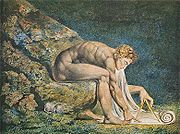
Newton (Blake)
Encyclopedia

English poetry
The history of English poetry stretches from the middle of the 7th century to the present day. Over this period, English poets have written some of the most enduring poems in Western culture, and the language and its poetry have spread around the globe. Consequently, the term English poetry is...
, painter
Painting
Painting is the practice of applying paint, pigment, color or other medium to a surface . The application of the medium is commonly applied to the base with a brush but other objects can be used. In art, the term painting describes both the act and the result of the action. However, painting is...
and printmaker William Blake
William Blake
William Blake was an English poet, painter, and printmaker. Largely unrecognised during his lifetime, Blake is now considered a seminal figure in the history of both the poetry and visual arts of the Romantic Age...
first completed in 1795, but reworked and reprinted in 1805. It is one of the 12 "Large Colour Prints" or "Large Colour Printed Drawings" created between 1795 and 1805, which also include his series of images on the biblical ruler Nebuchadnezzar
Nebuchadnezzar (Blake)
Nebuchadnezzar is a colour monotype print with additions in ink and watercolour portraying the Old Testament Babylonian king Nebuchadnezzar II by the English poet, painter and printmaker William Blake...
.
Isaac Newton
Isaac Newton
Sir Isaac Newton PRS was an English physicist, mathematician, astronomer, natural philosopher, alchemist, and theologian, who has been "considered by many to be the greatest and most influential scientist who ever lived."...
is shown sitting naked and crouched on a rocky outcropping covered with algae, apparently at the bottom of the sea. His attention is focused upon diagrams he draws with a compass upon a scroll that appears to unravel from his mouth.. The compass is a smaller version of that held by God in Blake's The Ancient of Days
The Ancient of Days
The Ancient of Days is the title of a design by William Blake, originally published as the frontispiece to a 1794 work, Europe a Prophecy. It shows a figure, the Ancient of Days, crouching in a circular design with a cloud-like background. His out-stretched hand holds a compass over the darker void...
.
Blake's opposition to the enlightenment was deeply rooted. He wrote in his annotations to the Laocoon "Art is the Tree of Life. Science is the Tree of Death." Newton's theory of optics was especially offensive to Blake, who made a clear distinction between the vision of the "vegetative eye" and spiritual vision. The deistic
Deism
Deism in religious philosophy is the belief that reason and observation of the natural world, without the need for organized religion, can determine that the universe is the product of an all-powerful creator. According to deists, the creator does not intervene in human affairs or suspend the...
view of God as a distant creator who played no role in daily affairs was anathema to Blake, who regularly experienced spiritual visions. He opposes his "four-fold vision" to the "single vision" of Newton, whose "natural religion" of scientific materialism he characterized as sterile.
Newton was incorporated into Blake's infernal trinity along with the philosophers Francis Bacon
Francis Bacon
Francis Bacon, 1st Viscount St Albans, KC was an English philosopher, statesman, scientist, lawyer, jurist, author and pioneer of the scientific method. He served both as Attorney General and Lord Chancellor of England...
and John Locke
John Locke
John Locke FRS , widely known as the Father of Liberalism, was an English philosopher and physician regarded as one of the most influential of Enlightenment thinkers. Considered one of the first of the British empiricists, following the tradition of Francis Bacon, he is equally important to social...
.
Further reading
- Ault, DonaldDonald AultDonald Ault is a professor at the University of Florida and is primarily known for his work on British Romantic poet William Blake and American comics artist Carl Barks...
(1974) Visionary Physics: Blake's Response to Newton Chicago: University of Chicago Press. ISBN 0226032256 - Nicholson, Majorie Hope (1963) Newton demands the muse: Newtons̓ Opticks and the eighteenth century poets Archon Books
- Townsend, Joyce (ed.). William Blake: The Painter at Work. London: Tate PublishingTate Publishing LtdTate Publishing is a publisher of visual arts books, associated with the Tate Gallery in London, England. It was established in 1911; nowadays it is a division of Tate Enterprises Ltd, an independent company wholly owned by the Trustees of Tate, and is based at Tate Britain, Millbank, London...
, 2003. ISBN 1-85437-468-0

